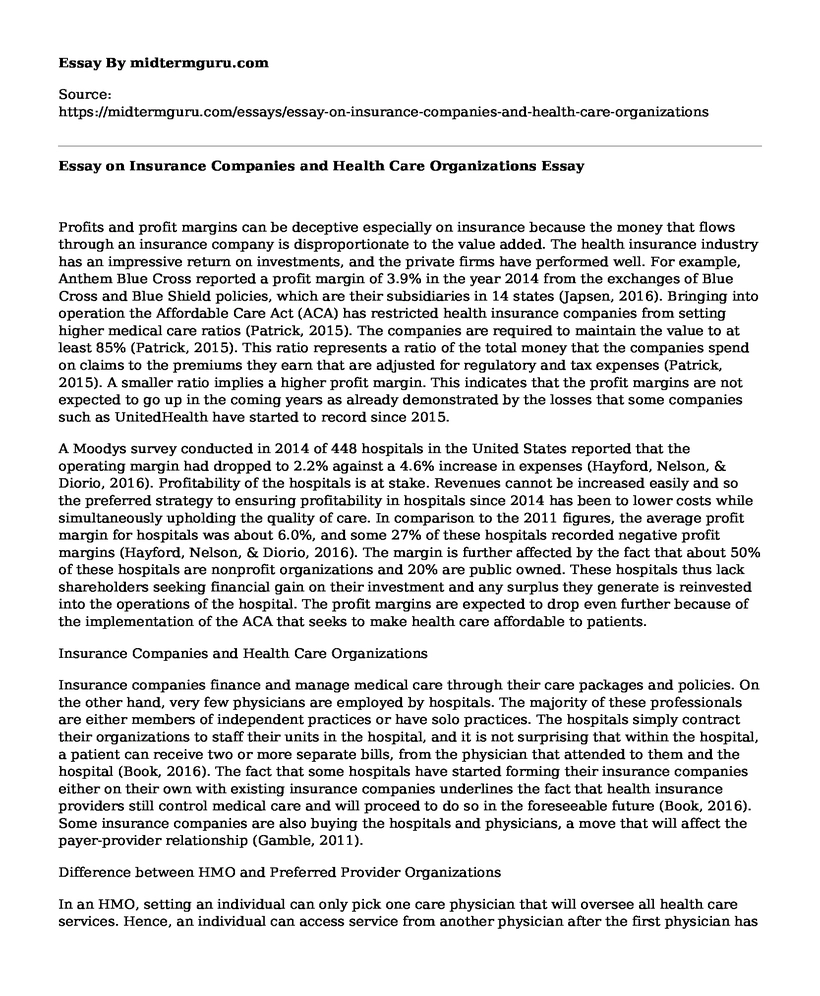Profits and profit margins can be deceptive especially on insurance because the money that flows through an insurance company is disproportionate to the value added. The health insurance industry has an impressive return on investments, and the private firms have performed well. For example, Anthem Blue Cross reported a profit margin of 3.9% in the year 2014 from the exchanges of Blue Cross and Blue Shield policies, which are their subsidiaries in 14 states (Japsen, 2016). Bringing into operation the Affordable Care Act (ACA) has restricted health insurance companies from setting higher medical care ratios (Patrick, 2015). The companies are required to maintain the value to at least 85% (Patrick, 2015). This ratio represents a ratio of the total money that the companies spend on claims to the premiums they earn that are adjusted for regulatory and tax expenses (Patrick, 2015). A smaller ratio implies a higher profit margin. This indicates that the profit margins are not expected to go up in the coming years as already demonstrated by the losses that some companies such as UnitedHealth have started to record since 2015.
A Moodys survey conducted in 2014 of 448 hospitals in the United States reported that the operating margin had dropped to 2.2% against a 4.6% increase in expenses (Hayford, Nelson, & Diorio, 2016). Profitability of the hospitals is at stake. Revenues cannot be increased easily and so the preferred strategy to ensuring profitability in hospitals since 2014 has been to lower costs while simultaneously upholding the quality of care. In comparison to the 2011 figures, the average profit margin for hospitals was about 6.0%, and some 27% of these hospitals recorded negative profit margins (Hayford, Nelson, & Diorio, 2016). The margin is further affected by the fact that about 50% of these hospitals are nonprofit organizations and 20% are public owned. These hospitals thus lack shareholders seeking financial gain on their investment and any surplus they generate is reinvested into the operations of the hospital. The profit margins are expected to drop even further because of the implementation of the ACA that seeks to make health care affordable to patients.
Insurance Companies and Health Care Organizations
Insurance companies finance and manage medical care through their care packages and policies. On the other hand, very few physicians are employed by hospitals. The majority of these professionals are either members of independent practices or have solo practices. The hospitals simply contract their organizations to staff their units in the hospital, and it is not surprising that within the hospital, a patient can receive two or more separate bills, from the physician that attended to them and the hospital (Book, 2016). The fact that some hospitals have started forming their insurance companies either on their own with existing insurance companies underlines the fact that health insurance providers still control medical care and will proceed to do so in the foreseeable future (Book, 2016). Some insurance companies are also buying the hospitals and physicians, a move that will affect the payer-provider relationship (Gamble, 2011).
Difference between HMO and Preferred Provider Organizations
In an HMO, setting an individual can only pick one care physician that will oversee all health care services. Hence, an individual can access service from another physician after the first physician has referred him or her. The insurance plan does not cover care received outside the network. In a PPO plan on the other hand, an individual does not a primary care physician, staying inside a particular network affords the individual with full coverage, and small copays whereas accessing care outside a network brings higher costs and some services are not covered under the plan.References
BIBLIOGRAPHY \l 1033 Book, R. (2016). Why are hospitals buying physician practices and forming insurance companies. Retrieved 2017, from American Action Forum: https://www.americanactionforum.org/research/why-are-hospitals-buying-physician-practices-and-forming-insurance-companies/
Gamble, M. (2011, July). The Quiet Takeover: Insurers Buying Physicians and Hospitals. Retrieved 2017, from Becker Hospital Review: http://www.beckershospitalreview.com/hospital-management-administration/the-quiet-takeover-insurers-buying-physicians-and-hospitals.html
Hayford, T., Nelson, L., & Diorio, A. (2016). Projecting hospitals' profit margins under several illustrative scenarios. Washington, DC: Congressional Budget Office .
Japsen, B. (2016). Anthem Gains Obamacare Customers And Sees Profits, Expansion Ahead. Retrieved 2017, from Forbes.com: https://www.forbes.com/sites/brucejapsen/2016/04/27/anthem-gains-184k-obamacare-customers-and-sees-profits-ahead/#d76238c3de8f
Patrick, M. (2015). Anthems Medical Care Ratio Improves, Boosts Profit Margin. Retrieved 2017, from Market Realist: http://marketrealist.com/2015/04/anthems-medical-care-ratio-improves-boosts-profit-margin/
Cite this page
Essay on Insurance Companies and Health Care Organizations. (2021, Jun 17). Retrieved from https://midtermguru.com/essays/essay-on-insurance-companies-and-health-care-organizations
If you are the original author of this essay and no longer wish to have it published on the midtermguru.com website, please click below to request its removal:
- Main Ethical Issues in Audit Firms - Paper Example
- AT&T Inc Company Financial Analysis Paper Example
- Essay on Madoff Ponzi Scheme
- Paper Example on Pros and Cons of National Health Insurance
- Research Paper on Ratio and Financial Statement Analysis
- 200+ Years of Financial Services: BMO Harris Bank - Research Paper
- Behavioral Finance: Psychology of Investors and Market Impact - Essay Sample







